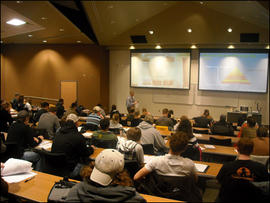Football, shmootball: Ohio State gets serious in the classroom
Long known mostly for its football team and marching band, Ohio State can now boast an academic status that’s the peer of its athletic prowess.
No Big Ten school has seen the test scores of incoming freshmen climb as fast as Ohio State since 2001. And among public schools in the Big Ten (Northwestern, which is private, has long led on test scores), Ohio State is now second only to Michigan.
Once a school with near open enrollment, Ohio State has scored big in the classroom by making a multi-million-dollar investment in better facilities, talented professors and improved opportunity.
It’s gotten to the point where the tougher standards have prompted a common refrain among alumni: I couldn’t get into the school today.
Consider: In 2001, a student who scored a 25 (out of 36) on the ACT would have been squarely in the middle of OSU’s incoming freshmen class. Now they’d be in the bottom quarter. Ohio State has seen it’s “middle 50” scores – akin to football goalposts representing the 25th and 75th percentiles of freshmen scores – jump from 23-28 in 2001 to 27-31 in 2013.
OSU’s eagerness to attract higher-achieving students stands in contrast with Michigan State, whose freshmen ACT scores have risen only one point since 2001. While Ohio State and other schools, including the University of Michigan, Iowa and Purdue, have made admission markedly more competitive, MSU officials say they try to balance selectivity with keeping Michigan State accessible to a broad range of in-state students.
OSU getting second looks
How big a change has Ohio State made? No other Big Ten school saw a four-point jump at either the 25th or 75th percentile.
And while 23 is better than 69 percent of all ACT test takers; a 27 is better than 87 percent of ACT test takers nationally. At the top end, the goalpost moved from 91 percent (28) to 97 percent (31).
By raising expectations for incoming students, OSU has succeeded in catching the attention of top students in Ohio and across the country.
“The increase in the ACT range has changed the perception of OSU in their eyes,” said Vern Granger, director of admissions at Ohio State. Top high school seniors, according to Granger, now see the school as the academic peer of Michigan and Illinois and in the same orbit as the University of Virginia and the University of North Carolina, other large public universities with highly selective admissions.
It hasn’t always been that way. As recently as 2001, OSU was looking up at far smaller Miami University of Ohio when it came to incoming student test scores, a ranking that rankled and one that OSU was already working to reverse.
In the 1990s, Granger said school leaders made a pledge: Improve Ohio State, stem to stern. It bulked up its programs and created a better environment for professors. It poured millions into specific programs, focused on recruiting top professors, setting aside additional money to lure them to Columbus.
It developed internship programs for undergrads and touted their successes. From 1995 to 2003, the average ACT score of incoming freshmen rose from 22.8 to 25.4, a trend that has continued for the next decade.
The school’s improvement fed a boon in out-of-state applications and admissions. While just 14 percent of students in 2004 came from beyond Ohio’s borders, 28 percent did in 2013.
“That speaks to the reputation and the brand that the university has become,” Granger said.
At what cost
Ohio State’s growing allure had a ripple effect on Miami, the former No. 1 public school in Ohio, at least in test scores. Miami began to recruit more aggressively outside of Ohio as the pool of top Buckeye students gravitated to Columbus.
“We’re battling it out on the ground,” said Michael Kabbaz, vice president for enrollment management at Miami. The school now gets roughly 40 percent of its students from out of state.
It’s outside of Ohio that Ohio State has burnished its image, one incoming freshmen class at a time.
“I think there’s no doubt that we’ve become, as far as reputation, a national university,” Granger said.
Game on.
Michigan Education Watch
Michigan Education Watch is made possible by generous financial support from:
Subscribe to Michigan Health Watch
See what new members are saying about why they donated to Bridge Michigan:
- “In order for this information to be accurate and unbiased it must be underwritten by its readers, not by special interests.” - Larry S.
- “Not many other media sources report on the topics Bridge does.” - Susan B.
- “Your journalism is outstanding and rare these days.” - Mark S.
If you want to ensure the future of nonpartisan, nonprofit Michigan journalism, please become a member today. You, too, will be asked why you donated and maybe we'll feature your quote next time!


 Yes, Michigan, they do have classrooms in Columbus. The quality of their incoming students now rivals UM, at least in ACT scores. (Courtesy photo)
Yes, Michigan, they do have classrooms in Columbus. The quality of their incoming students now rivals UM, at least in ACT scores. (Courtesy photo)